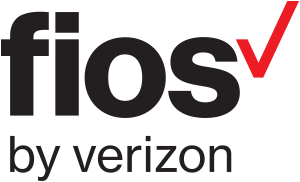Verizon Fios facts for kids

Verizon Fios logo, 2015-present
|
|
| Subsidiary | |
| Industry | TV, Internet, & phone |
| Founded | September 22, 2005 Keller, Texas, U.S. |
| Headquarters |
,
U.S.
|
| Parent | Verizon Consumer |
| Divisions | JuniorNet |
Verizon Fios is a bundled Internet access, telephone, and television service provided by Verizon Communications that operates over a fiber optical network within the United States.
Contents
History
Early development (1995–1996)
The early stages of Fios began when Bell Atlantic (now Verizon Communications) was testing its video service "Stargazer" in 1995. This was the first commercial video on demand (VOD) service, which was tested for 1,000 homes in northern Virginia. During this time there were talks of developing a fiber optic-based service. In 1996, VP of Programming Bob Townsend told the Baltimore Sun that Stargazer would be "folded into [Bell Atlantic's] deployment of fiber to the curb."
Launch and expansion (2005–2010)
In September 2005, Verizon Communications began offering a fiber optic digital television service, which became available for 9,000 customers in Keller, Texas. Called Fios TV, the service aimed to replace copper wires with optical fibers.
By 2006 Fios was offered in areas of seven US states.
Stable footprint (2010–present)
Verizon announced in March 2010 that it was winding down its Fios expansion, concentrating on completing its network in areas that already had Fios franchises but were not deploying to new areas, which included the cities of Baltimore and Boston, which had not yet secured municipal franchise agreements. Some viewed the halt in expansion as a violation of Verizon's agreements with some municipalities and states, since Verizon has collected revenue to deploy infrastructure upgrades that never occurred. In New Jersey, Verizon collected an additional $15 billion in fees from customers and tax subsidies in exchange for promising fiber optic broadband for the whole state. The New Jersey state government altered the deal in 2014 to allow Verizon to substitute wireless Internet access to fulfill its promise instead. Critics pointed out that wireless Internet was slower and less reliable.
Television
Fios TV is one of three services offered by Verizon Fios. Verizon offers Fios packages with high-definition and standard-definition TV, as well as video on demand.
Fios TV uses QAM technology to deliver signals to a customer's property using its fiber optic cables. At the home, the optical network terminal turns the signal into a radio frequency signal that can be used on a home's existing coaxial cables, feeding the signal to a set-top box (STB).
Internet access
Fios Internet was the first service offered under Verizon's Fios brand, and is one of three of the product line's current offerings. The broadband Internet service initially launched in Keller, Texas, in 2004, a year before Fios TV was available.
Telephone
In addition to its TV and Internet services, the company also has a voice over IP service via its fiber-optic network, Fios Digital Voice. The service initially launched in Virginia and Maryland in September 2008 and eventually fully replaced an earlier service, VoiceWing, which Verizon offered from 2004 to early 2009.
While Verizon also offers plain old telephone service (POTS), it has been reported in various markets that Verizon physically disconnected the copper lines for copper-line phone service at the time that Fios was installed.
Being a VoIP service, a FiOS phone connection will not work if the power is out. To mitigate this, a backup battery is included.
Carriage disputes
The Weather Channel carriage dispute
On March 10, 2015, at midnight EDT, The Weather Channel and its sister network, Weatherscan, were pulled from Verizon Fios after the two parties were unable to come to terms on a new carriage agreement. The services have respectively been replaced by the AccuWeather Network (which launched on March 13) and a widget provided by Fios featuring forecast content provided by WeatherBug. No public announcement was made regarding the removal until over 12 hours after TWC and Weatherscan were pulled. The Weather Channel offered a less expensive deal to Verizon Fios, which rejected the offer. Verizon cited the wide availability of the Internet and mobile apps for consumers to access weather content any time of day as the reason for dropping TWC and its services.
The Weather Channel had earlier signed renewal agreements with major providers that are members of the National Cable Television Cooperative (NCTC), including Time Warner Cable and Cox Communications. While Verizon claimed it was a long-term business decision (instead of a carriage dispute), The Weather Channel launched a campaign to urge viewers to contact Fios about restoring the cable channel and its services.
It was announced on June 19, 2019, that The Weather Channel would return to Fios carriage beginning June 24, 2019.
ESPN lawsuit
In April 2015, ESPN Inc. sued Verizon for breaching its carriage contract by offering ESPN and ESPN2 as part of a separate sports package under its new "Custom TV" service. ESPN's contract requires the two networks to be part of the basic service. Verizon and ESPN reached a deal in May 2016. The terms of the deal were not made public.
Cablevision lawsuit
On May 19, 2015, Cablevision sued Verizon in the Southern District of New York to challenge Verizon's claim that it is 100 percent fiber-based. Cablevision started an advertising campaign to take the case mainstream. The two companies agreed to end the dispute in September 2015. The terms of the deal were not disclosed at the time.
See also
 In Spanish: Verizon FiOS para niños
In Spanish: Verizon FiOS para niños
- Fiber-optic communication
- List of multiple-system operators

